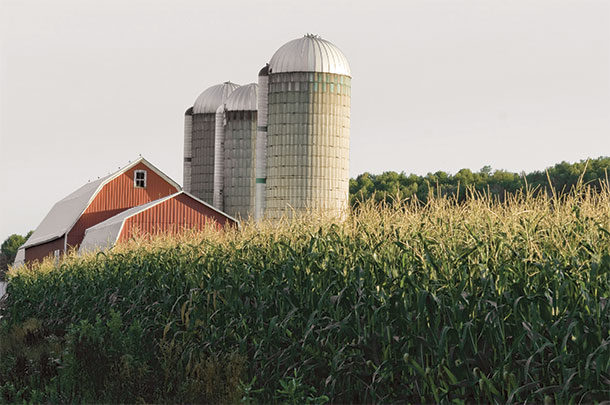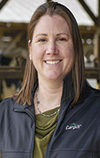When you grow up on a dairy farm, it can be hard to see the dangers that exist all around you. From low-hanging beams in barns to the loose ladder on the silo or small rise in the cement, we can become complacent to these risks that surround us. When you combine those factors with the amount of times we find ourselves rushing to get all the chores done in the day, the risk of serious injury or fatality rises.
However, it doesn’t have to be this way. We can sharpen our focus on safety and take actions to avoid accidents and maybe even save a life. By taking time to reflect on how we prioritize safety, what protocols we do or don’t implement and learning from one another, we can make dairy farms safer for our employees and families.
Acknowledge high-risk areas
Have you taken time to identify the areas on your farm that are most dangerous to employees, family or visitors? For Yves Chanvert at Ferme Sony in Val-Joli, Quebec, safety is a priority for everyone on their farm. “People’s health comes first,” Chanvert says. “Whether a team member or just a visitor, safety is paramount to limit the risk of injury.”
At Ferme Sony, Chanvert notes the dangers of silo gases as the biggest risk to their operation. To minimize that risk, Ferme Sony makes sure to close the silos no more than one hour after the last silage trip. “As soon as the silage is completed, we immediately close the silos, even if it is after midnight,” Chanvert says. “Then we are sure no one gets into these silos for the coming weeks.”
Beyond the silo, some other high-risk areas worth addressing are high-traffic areas, blind spots where cross-traffic could collide, unexpected steps or lifts in cement, children’s play areas, pens with bulls, etc. By taking time to consider where something could go wrong, you can then begin to strategize ways to prevent the unthinkable from occurring and draft those ideas into safety protocols.
Prioritize safety protocols
For Ferme Sony, prioritizing the highest safety risks are of utmost importance, and equally important is ensuring that the safety measures in place are respected. For example, chemicals are very harmful. Thus, each employee has training on the handling of these and the importance of wearing personal protective equipment (gloves and goggles). According to Chanvert, training is the key. If an employee is aware of the danger, they will wear the equipment even when the owners are not present to observe them. Thus, the [action] becomes automatic.
In addition, each of the engines and PTOs have their guards installed. This limits the danger; however, Chanvert mentions that you should never trust a guard. The basis of safety is to stay away from moving parts. Again, training is the basis in this type of work. Each employee is trained to operate a type of machinery. Thus, during ensiling, only one employee manages the blower. This employee is trained to do so, and this greatly reduces the risk of injury. Employees avoid moving from one machine to another during the day. In order to reduce the risk of falling, Chanvert has also just installed a lifeline on his silo.
For Gabriel Boutin, owner of Ferme Hétrière in St-Charles-de-Bellechasse, Quebec, safety protocols became a top priority after a farm accident occurred in 2018 when he fell into the silo – a traumatic incident no farm ever wants to go through. The experience caused Boutin to recognize the opportunity to be more proactive when it came to their safety protocols, and now a safety harness is required to be worn by anyone entering the silo. In addition to implementing harness usage, the farm also put in place several guards and barriers throughout the barn to reduce the risk of falls.
In the next few years, Boutin plans to implement more and more safety protocols as children grow up and will visit the barn more and more frequently. In addition to these protocols, he plans to put up posters in the lane way to limit the speed of visitors coming onto the farm. Have your children wear bright colour or reflective clothing (safety vests) when they are on-farm, so they are more visible. Encourage farm workers and visitors to park their vehicle or farm equipment facing towards the direction they need to go next, which maximizes their visibility and reduces the risks compared to backing up.
Speak up for safety
If you see something risky on your farm, or a neighbour’s, have the courage to speak up and address the danger. Chances are the person might not even be aware of how unsafe what they are doing could be. Furthermore, encourage everyone on your farm to be a safety champion. When family and employees are encouraged to address risky situations, it can go a long way in preventing accidents, especially for visitors coming onto the farm who might not know their way around.
Both Chanvert and Boutin were willing to speak up and share their safety practices for the benefit of everyone in the industry. When asked what safety advice they have for other dairy farmers, Chanvert says, “Never climb into silos on the first day they’ve been filled. The gases are invisible, and sometimes the ventilation is not sufficient.” The final safety thought Boutin wanted to share is simple but powerful, “It just takes an accident to create a fatality. Take action before something bad happens.”
Help us build a stronger safety culture for dairy farmers across Canada. Follow Purina ProActiv on Facebook for more helpful safety information. We also encourage you to share your own safety stories and tips with the hashtag #dairysafety #purinapracticessafety.










